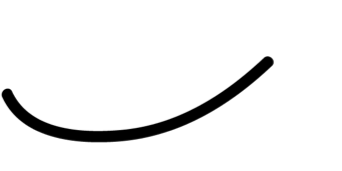MODULE: Gestalt theory
Step 08 of 16: Continuity/Continuation
An important Law in suggesting movement in static imagery is the Law of Continuity/Continuation. The Law suggests that the mind develops expected trajectories as it follows paths, and interprets them again as a whole, even when the end destination of the path is not explcitly mapped or plotted on the page. In the image below, the curve of the line carries with it associations of movement (most probably from left-to-right, especially in western contexts) and of speed (perhaps gaining momentum and flicking quickly off the right) even though the line itself makes no suggestion of either. The eye follows these lines as if being led and as a result the shape of the lines can lend character to the movement. For example smooth curvateous paths that conform to our experience of graceful movement evoke associations of elegance and may end pleasantly because the end point of contuinity is easy to anticipate (following a predictable curvature), while jagged lines denote harsh changes in direction which could carry with them associations of uncertainty and alertness (no certain outcome and requiring attention in anticipation of change).

Designers considering layout and composition frequently make reference to "leading the eye" through the page or positioned elements. This is a particularly important consideration is visual communication as the composure of a page can be decided by the paths identifiable and the lines employed. The whole character of the page can be influenced by the aforementioned moods created by the employment of lines and paths, not just as literal lines with visible stroke weights, but also the paths created by negative space and margins. Not to mention the all-important positioning of the "call to action" at the anticipated end-point of the composition. Placing it elsewhere creates confusion and aggravation, making it important to create a strong line of continuity ending in an actionable option or message.